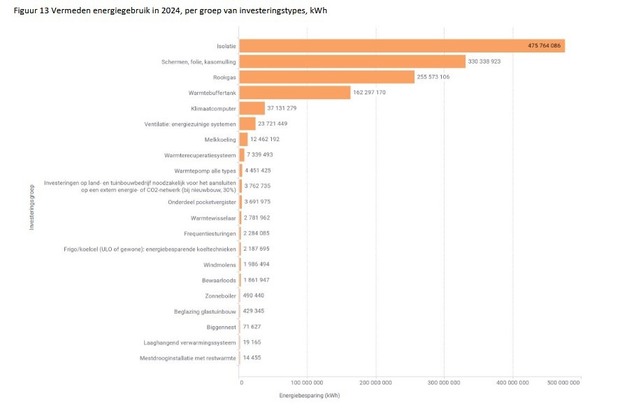The Flemish agriculture and horticulture sector is making solid progress in sustainability, thanks in part to financial support for farm investments from the Flemish Agricultural Investment Fund (VLIF). A recent analysis looked at investments made between 2016 and 2024, focusing in particular on their impact on energy use.
Over 9,000 individual investments carried out during this period resulted in a combined energy saving of more than 1,300 GWh by 2024. These projects received a total of €87.7 million in financial support. That energy saving also led to a significant reduction in greenhouse gas emissions: in 2024 alone, 213 kilotons of CO₂ emissions were avoided.
Key investment categories supported by VLIF, across both agriculture and horticulture, include insulation for heated livestock housing, energy-saving screens and greenhouse films, and flue gas treatment systems. Of these, investments in screens, films, and greenhouse coverings accounted for 25% of the total CO₂ emissions reduction, while flue gas treatment contributed 19%.
Water-related sustainability also received attention. Around €14 million in funding went toward projects aimed at improving water quality and efficiency. Between 2017 and 2024, a total of 2,412 investments were made to increase on-farm water storage capacity, resulting in nearly 2 million cubic meters of additional storage, mostly for collecting rainwater.
Investments in horticulture
In addition to support for greenhouse screens, films, coverings, and flue gas treatment systems, the VLIF also provided funding for other energy-saving technologies. This includes battery storage for renewable energy (24 projects), advanced greenhouse glazing such as diffused or anti-reflective (AR) glass (54 projects), connections to external energy or CO₂ networks (5 projects), LED lighting systems (2,210 projects), and LEDs with integrated fixtures (62 projects).
Within the screen category, energy-saving screens were the most popular choice, installed in 188 projects.
The analysis also notes that VLIF never funds the construction of entire greenhouses, only specific components. For new greenhouses, the VLIF support represents just a small portion of the total investment. As a result, VLIF subsidies are rarely the deciding factor in whether or not a project goes ahead, they help, but they don't determine the outcome on their own.
 © Dumez L. & Merckx S. (2025) VLIF: van investering tot impact. Duurzaamheidseffecten van de VLIF-investeringssteun, Agentschap Landbouw en Zeevisserij, Brussel.
© Dumez L. & Merckx S. (2025) VLIF: van investering tot impact. Duurzaamheidseffecten van de VLIF-investeringssteun, Agentschap Landbouw en Zeevisserij, Brussel.
